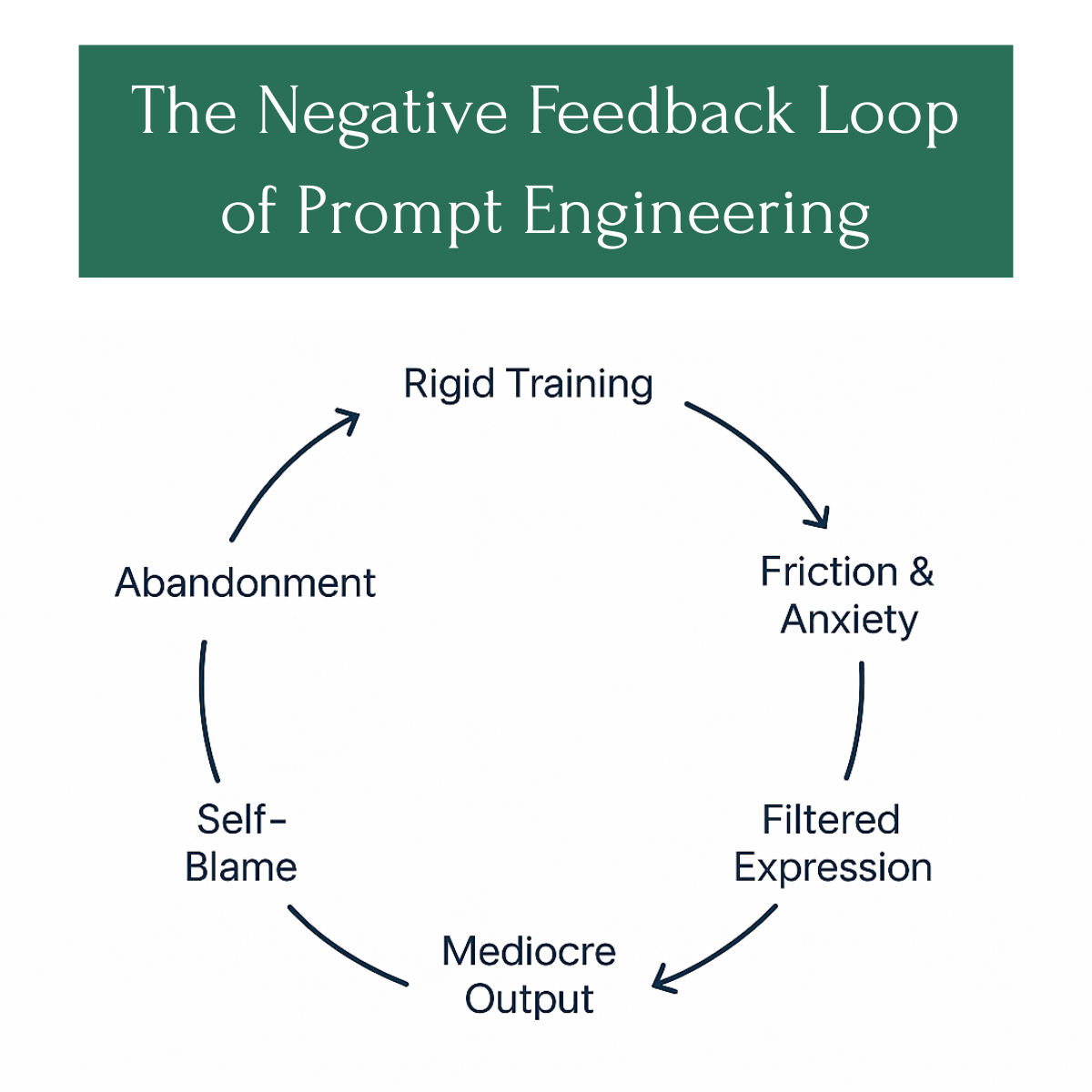How AI’s Legacy Mindset Alienates Intuitive Thinkers and Stifles Innovation

AI has dramatically evolved, becoming increasingly intuitive, conversational, and accessible to anyone capable of everyday communication. Yet the dominant approach for interacting with AI models—prompt engineering—still carries a legacy bias, shaped by technical mindsets and methods originally designed by and for engineers.
This bias has created a hidden negative feedback loop, disproportionately alienating intuitive, creative thinkers, especially women, senior leaders, and non-technical professionals, who represent the vast majority (85-90%) of potential AI users.
Let's break down exactly how this negative feedback loop operates, why it matters, and what we can do to move beyond it.
Understanding the Negative Feedback Loop
The cycle unfolds as follows:
1. Rigid Training:
Prompt engineering relies heavily on precise syntax, exact phrasing, and structured command inputs. This rigid style reflects the linear, structured communication preferences of engineers, and implicitly assumes all users think and communicate similarly.
2. Friction & Anxiety:
Intuitive thinkers, creative professionals, and senior leaders whose success has often hinged upon nuanced, strategic, and relational communication styles find this rigidity deeply unnatural. It creates anxiety and friction, forcing users into cognitive patterns that do not feel intuitive or comfortable.
3. Filtered Expression:
Faced with the fear of producing ineffective prompts, users begin restricting their natural and authentic styles of communication. The resulting input is stiff, overly cautious, and less creative. This filtering further disconnects users from genuine, effective collaboration with AI.
4. Mediocre Output:
AI outputs inevitably reflect input quality. Constrained, overly engineered inputs lead to underwhelming, superficial, or irrelevant results. Users frequently conclude—incorrectly—that the AI itself is inadequate, rather than recognizing the root cause in the prompting methodology.
5. Self-Blame:
Experiencing repeated frustrations and mediocre results, users often internalize these difficulties, attributing the shortcomings to personal inadequacies. They begin to believe they simply aren’t "technical enough" or smart enough to leverage AI effectively. This stage disproportionately affects women and experienced leaders, reinforcing existing biases around technical competency.
6. Abandonment:
Ultimately, many users disengage from AI entirely. Feeling frustrated, inadequate, and disillusioned, they walk away convinced these powerful new technologies "just aren’t meant" for people like them. Organizations lose invaluable potential contributors, and the diversity of AI engagement narrows even further.
Why Prompt Engineering Represents a Legacy Mindset
Prompt engineering originated in a context where AI interactions were strictly technical, linear, and command-driven. Early AI models demanded rigid structure because they lacked the linguistic flexibility and intuitive understanding inherent in today's sophisticated conversational AI systems.
Modern AI—especially models like ChatGPT and other advanced GPT-based platforms—have fundamentally evolved. They now understand natural human language, infer context, manage nuance, and handle loosely structured input gracefully.
Yet, despite these advancements, prompt engineering methods continue to dominate AI education, corporate training, and general usage patterns. This persistence represents an outdated bias—anchored in traditional engineering preferences rather than reflecting the true capabilities of contemporary AI.
The High Cost of Alienating Intuitive Thinkers
The persistence of prompt engineering isn't merely inconvenient; it's strategically costly.
- Innovation Loss:
Creative professionals, strategic leaders, and senior executives bring insights, intuition, and problem-solving abilities that deeply complement AI. Alienating these users robs organizations of their most experienced and insightful voices. - Exclusion of Diverse Perspectives:
Women and senior professionals—who often excel in intuitive and relationship-driven communication—are disproportionately impacted. Excluding these groups means AI development, training, and deployment continues along narrow, homogenous lines, limiting potential insights and innovations. - Stunted Organizational Adoption:
Organizations spend billions annually to adopt AI, yet adoption rates remain low precisely because the dominant prompt engineering methodologies alienate mainstream users. The barrier isn’t AI technology itself, but rather the inadequate, outdated frameworks for interacting with it.
A New Path Forward: Intuitive AI Interaction
To fully unlock AI’s potential, we must shift from rigid, engineering-centric approaches to intuitive, conversational interactions.
Key strategies for shifting this paradigm include:
- Conversational AI Training:
Focus on dialogue-based methodologies that mirror natural human interactions, rather than artificially structured commands. Empower all users to confidently express themselves naturally. - Empathy-Driven Design:
AI interfaces and workflows should be explicitly designed around empathy, intuition, and ease of use, aligning closely with everyday communication habits of diverse user groups. - Inclusive Education:
Build training programs that value intuitive and strategic thinking skills as highly as technical precision. Create AI literacy programs that cater specifically to non-technical and leadership-level professionals. - Thoughtful Leadership Engagement:
Engage senior executives and intuitive thinkers early, explicitly highlighting their strategic value and potential contributions. Ensure AI initiatives align closely with their communication strengths and leadership insights.
Concluding Thoughts: Shaping the Future of AI Collaboration
Today's AI is no longer restricted by the rigid communication demands of legacy methods. Prompt engineering has inadvertently created significant barriers, excluding precisely those individuals who stand to gain the most—and contribute most significantly—to AI’s future.
As explored deeply in our latest white paper, overcoming these legacy biases and embracing intuitive, human-centered AI methodologies is no longer optional—it’s essential for inclusive innovation and strategic success.
By shifting from rigid, engineered interactions to natural, intuitive dialogue, we enable everyone, regardless of technical background, to become confident, empowered collaborators with AI.
This shift is not merely technological—it's deeply human. The future of AI depends on our ability to embrace diverse, intuitive minds and support authentic, inclusive communication.
Let's break the cycle, and unleash the true power of intuitive human-AI collaboration.
Learn more about Intuitive AI and the positive feedback loop.